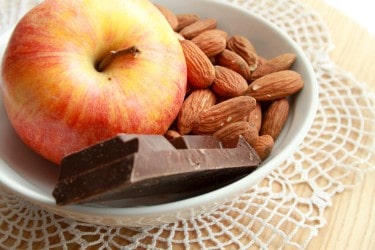nutrition
What Foods Have Magnesium? (And How to Integrate Them in to your Diet)
On This Page

Magnesium is an important mineral for your body. Adding some of these foods to your diet can help make sure your body is getting the magnesium it needs.
Magnesium is a major mineral in the body. Having a healthy magnesium level supports hundreds of biochemical reactions in your body. It may boost exercise performance, support brain health, support healthy blood sugar levels (already in normal range), and promote heart health.
Magnesium is a popular supplement. But the good news is that it’s also available in a wide and diverse array of foods. Incorporating some magnesium-rich foods into your diet can go a long way toward supporting your health goals. Let’s take a look at some of the best sources.
13 Foods That are Rich in Magnesium
1. Legumes
The term “legumes” describes a family of nutrient-dense plants: peas, lentils, beans, soybeans, and chickpeas. They’re rich in magnesium, as well as several other nutrients. Consider this: A one-cup serving of cooked black beans includes 120 mg of magnesium, or 30% of the recommended daily intake (RDI).
Other health benefits of legumes abound. They’re also a source of non-heme iron and potassium – and, for vegetarians especially, they can be a key source of protein. They may also support maintenance of healthy blood sugar levels and promote heart health.
2. Whole grains
The term “whole grains” can include wheat, oats, barley, and pseudocereals like buckwheat and quinoa. If you’re looking for some magnesium-rich foods, you can’t go wrong with incorporating some whole grains into your diet.
A one-cup of buckwheat, for example, will afford you about 393 mg of magnesium, or 93.5% of the RDA. Buckwheat is also a source of B-group vitamins and contains some macroelements and microelements, including sodium, potassium, copper, zinc, magnesium, iron, calcium, and manganese. Its nutrients and minerals make buckwheat flour a great nutrient dense option to use for making biscuits, breads, cakes, casseroles, cookies, crepes, pancakes, pasta noodles, soups, and confectionary products.
Oats also contain unique antioxidants, called avenanthramides, as well as vitamin E-like compounds, such as tocotrienols and tocopherols.
Quinoa, once known to the Incas as “the mother of all grains,” has been eaten as food and grown for over 5,000 years. It’s a pseudo-cereal that’s recognized as one of the world’s healthiest foods. In addition to being rich in magnesium (118 mg in 1 cup), it’s an excellent source of protein (8 g in 1 cup), along with its unsaturated fatty acids, minerals, vitamins, fiber, and antioxidants. Quinoa earned the title of superfood.
Whole grains in general tend to have several nutrients in comparison to bleached white flour B vitamins, selenium, manganese, polyphenols, and fiber, and they’ve been shown to be good for heart health.
3. Avocados
You may have noticed that avocados are quite popular these days, and that’s for good reason. First of all, they’re tasty. Secondly, they’re a great source of nutrients: they’re high in potassium, B vitamins, and vitamin K, and they’re also high in monounsaturated fat that’s great for your heart health. And, of course, they’re an excellent source of magnesium. A medium avocado (150g) will afford you 43.5 mg of magnesium or 10% of the daily value (DV). On top of all that, they’re also a great source of fiber.
4. Nuts and seeds
Nuts and seeds are also great sources of magnesium. Some nuts that are especially high in magnesium include Brazil nuts, cashews, and almonds. In fact, in 100 grams of cashews you have 292 mg of magnesium, which is 69.5% of the DV. Nuts make for great snacks and are also great for heart health. Most nuts are good sources of fiber, too.
5. Tofu
If you’re a vegetarian, odds are you know a thing or two about tofu – its high protein content makes it a favorite among people who don’t eat meat. Tofu is yet another source of magnesium: 100 grams contains 60 mg of magnesium, which amounts to 14% of the DV. The same 100 g amount will also provide you with 18 grams of protein, as well as some iron, manganese, selenium, and calcium. The health benefits of tofu are plentiful, with some studies suggesting that tofu has some beneficial properties that can support microbiome health and heart health.
6. Leafy Greens
If you’re looking to get more magnesium in your diet, you can’t go wrong with eating more leafy greens – you just have to pick the right ones. Some greens with a lot of magnesium include spinach, kale, collard greens, mustard greens, and turnip greens. A one-cup serving of cooked spinach will afford you 157 mg of magnesium, which comes out to 39% of the RDI; a one-cup serving of cooked kale offers 29.5 mg of magnesium or about 7% of the RDI. Greens are also a wonderful source of other nutrients, such as manganese, iron, and vitamins A, C, and K. You may also benefit from their many beneficial plant compounds, which support the health of your cells.
7. Bananas
Bananas are a highly nutritious fruit and have even been called a “superfood” by the American Medical Association. Famously a great source of potassium, bananas are also an excellent source of magnesium. The main variety of bananas sold in the United States and Europe – the ones you see whenever you go to the grocery store – is known as the Cavendish type.
One serving of a medium-sized banana contains 32 mg of magnesium. That said, one study showed that a Cavendish banana’s magnesium and potassium contents increased as the banana ripened. So, even if you don’t like the looks of a very ripe banana, remember: It’s got even more of the nutritional value you’re looking for! The combination of magnesium and potassium is why it’s recognized for being a valuable way to relieve exercise-related muscle cramps!
8. Dark chocolate
In addition to being delicious, dark chocolate contains magnesium. A one-ounce serving of 70-85% dark chocolate will afford you 64.6 mg in magnesium, or 15% of the DV. Dark chocolate also has additional nutrients, including iron, copper, and manganese – as well as flavanols with prebiotic-like properties that support your healthy gut bacteria. You can also benefit from dark chocolate’s many antioxidants, as the cacao seeds are nutrient dense and considered a “superfruit.” Dark chocolate also supports heart health. The flavonoids support endothelial function in healthy adults. The key to really benefiting from dark chocolate is to choose a product with at least 70% cocoa solids and if using cocoa powder go for the non-alkalized version for the most potent antioxidant content. If you can go higher, that’s even better for you!
9. Fatty fish
Fatty fish are packed with so many important nutrients that the American Heart Association recommends consuming at least 2 servings per week to support cardiovascular health. Among the various types of fatty fish, the ones with the highest magnesium content include salmon, sea bass, halibut, mackerel, and pollock. Mackerel is by far the best, containing 60 mg of magnesium per 100 grams. Sea bass is the second best, containing a whopping 41 mg per 100 grams. Alongside magnesium, fatty fish are also rich in omega-3 fatty acids and vitamin D, which are both vital for brain and heart health.
10. Dairy Products
Dairy products are not only excellent sources of calcium and protein, but they can also be a source of magnesium. The combination of calcium, magnesium, and protein is a great way to promote strong, healthy bones.
Among the top magnesium sources are cheeses, such as cheddar, parmesan, mozzarella, gruyere, and Swiss. Gruyere and parmesan are by far the top choices, containing 35-36 mg per 100 grams. Yogurt is also a great way to obtain magnesium, with nonfat and full-fat yogurts containing around 10-12 mg per 100 grams. For those who are lactose intolerant or avoid dairy, almond milk or cashew milk can be a good alternative.
11. Fruits
We all know fruits are a valuable part of any diet. They provide an important source of fiber, vitamin C, and antioxidants. And, they are a great way to boost your magnesium intake. Tamarind is by far the fruit with the highest concentration of magnesium, containing a whopping 92 mg per 100 grams, about 25% of the DV. Other nutritious options include passionfruit, papaya, raspberries, kiwi, cherry, and strawberries. Whether enjoyed fresh, blended into smoothies, or as part of a dessert, these fruits are a simple way to add more magnesium to your diet.
12. Baked beans
We mentioned earlier that legumes are a great magnesium source, but, particularly, baked beans are an excellent choice. Just one cup of baked beans contains 109 mg of magnesium, making them a top source of this essential mineral. Yet, their benefits don’t end there. They are also abundant in fiber, which aids in regulating digestive health and supports the maintenance of healthy cholesterol levels already within the normal range.
13. Chia Seeds
Chia seeds are by far the most concentrated source of magnesium on our list. They contain about 335 mg of magnesium per 100 grams, which is more than 100% of the DV! Along with magnesium, chia seeds are a rich source of fiber and are a natural source of omega-3 fatty acids, which are essential for promoting cardiovascular health. You can easily introduce chia seeds into your diet by incorporating them into an array of foods, such as smoothies, oatmeal, salads, or yogurt. Chia seeds can also be found in our Chia-Flax product.
Other questions about magnesium
What are the symptoms of a magnesium deficiency?
While clinical magnesium deficiencies may not occur all that often, you should still be on the lookout for the signs of one. Symptoms of a magnesium deficiency can include nausea, vomiting, fatigue, and muscle cramps. However, these symptoms aren’t just exclusive to a magnesium deficiency. If you are experiencing any of these symptoms, you should reach out to your healthcare provider.
Can I take too much magnesium?
The good news is that you typically can’t get too much magnesium from your diet, or from consuming the foods listed above; your kidneys will get rid of excess magnesium in your urine. Your only real risk of getting too much magnesium is if you’re taking high doses of magnesium in antacids or cathartic forms. According to the Council for Responsible Nutrition, the upper limit for supplemental magnesium is 400 mg per day for healthy adults.
Individuals consuming supplements should be aware that some antacids and laxatives also contain magnesium. Symptoms of magnesium toxicity are rarely seen. According to the IOM (Institute of Medicine), the most common primary initial presentation of excess magnesium is a loose stool. All other symptoms may be associated with those who have pre-existing kidney issues. You should always consult with a medical professional before taking a supplement.
How much magnesium should I consume daily?
The recommended dietary allowance (RDA) for magnesium can vary depending on factors like age, gender, and individual needs, but it typically ranges between 320-420 mg per day. By incorporating more of the foods from this list into your daily diet, you can easily meet these levels. Magnesium supplements are a great way to bridge any gaps.
The bottom line
If you’re concerned about not getting enough magnesium, you should incorporate some of the excellent foods listed above – as part of a balanced diet, of course. Eating well can help you get the nutrients you need, keeping your body in good shape.



